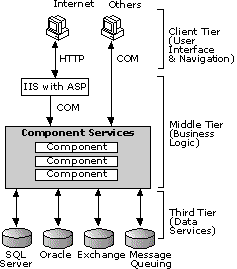Developing Web Applications |
The new system design logically divides computing tasks across the application. Viewed from a purely functional standpoint, most applications perform the following three main tasks: gathering user input, storing the input as data, and manipulating the data as dictated by established operational procedures. These tasks can be grouped into three or more tiers, which is why the new system design provides for three-tier, or multitier applications. The application tiers, shown in the figure below, are:

Application tiers don’t always correspond to physical locations on the network. For example, the middle and third tiers may coexist on the same server running both IIS 5.0 and SQL Server, or they could be separate. The middle tier alone may tie together several computers, and sometimes the server becomes a client itself.
Separating the application into layers isolates each major area of functionality. The presentation is independent of the business logic, which is separate from the data. Designing applications in this way has its tradeoffs; it requires a little more analysis and design at the start, but greatly reduces maintenance costs and increases functional flexibility in the end.
The explosive growth of the Internet is a strong motivation for organizations to adopt n-tier architectures in their products. However, organizations still face challenges. How can they take advantage of new technologies while preserving existing investments in people, applications, and data? How can they build modern, scalable computing solutions that are dynamic and easy to change? How can they lower the overall cost of computing while making complex computing environments work? One solution is Microsoft® Windows® Distributed interNet Applications (DNA).